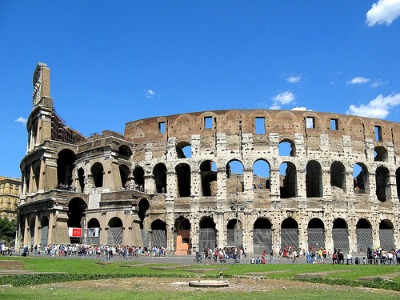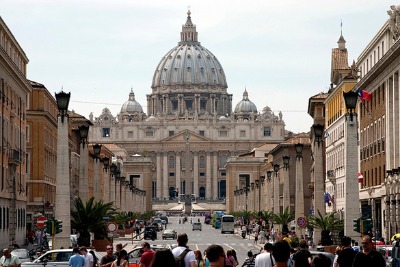How to Conquer Rome in a Day
 I’ve said more than once that Rome overwhelms me. Even with a few days in the Italian capital, I feel like I haven’t come close to seeing everything and I’ve spent a lot of time just getting from place to place. I always recommend that people allot at least three days for Rome, if not more. So when I got a note from today’s guest author, Lani Thorpe, about how to see the sights of Rome in a single day, I was intrigued.
I’ve said more than once that Rome overwhelms me. Even with a few days in the Italian capital, I feel like I haven’t come close to seeing everything and I’ve spent a lot of time just getting from place to place. I always recommend that people allot at least three days for Rome, if not more. So when I got a note from today’s guest author, Lani Thorpe, about how to see the sights of Rome in a single day, I was intrigued.
While there are plenty of things to see and do in Rome that are left out of Lani’s itinerary, anyone who managed to accomplish the things that are included in the space of a one-day visit to Rome deserves high praise. This itinerary is particularly useful for people who have a long layover in Rome en route to somewhere else, but it’s also potentially useful if you’re flying in or out of Rome but you’re concentrating your trip elsewhere in Italy and you only have a day to spend in the Eternal City.
And as for the rest of Rome? You’ll just have to come back and see it another time. It is the Eternal City, after all – it’ll be there when you return.
Conquering the Sights of Rome in a Day
It’s the city that famously wasn’t built in a day, but that doesn’t mean you can’t see the essential Rome sights in one day. Sure, you could easily spend weeks or more getting to know the ins and outs of Italy’s capital, but what if you’ve got just a 12-hour stopover and still want to cross a few to-dos off your sightseeing list? It can be done, trust me. With a few careful choices you can bask in the glory of this ancient city and make your connecting trip without breaking a sweat.
There are some sights that simply can’t be overlooked, unless you want to deal with the inevitable scoffing question: “You went to Rome and you didn’t see the Colosseum/Vatican/Trevi Fountain?” from others. But the trick with a quick stopover is to be selective. Three of the big guns you can definitely fit into a one-day itinerary include all of the above, plus ample time for a nice lunch break and mid-afternoon gelato stop.
Getting from the airport into the city
Catch the Leonardo Express, which runs every 30 minutes and takes you directly from Fiumicino Airport to Roma Termini, the city’s central train station, in 31 minutes. Fares cost 14 to 15 euros, depending on where you purchase, and tickets are available at station ticket counters, automated ticketing machines, and some newsagents. Remember to validate your ticket at one of the validation machines before boarding the train.
Riding the Rome metro
The Metropolitana, as it’s known by locals, is a fool-proof way of getting around some of the central Roman sights. Keeping it nice and simple, there are just two lines, the A and the B (both of which intersect the central Termini station), and both have stops at or very near to most important historical landmarks. Especially helpful for the confused tourist are the little graphics accompanying certain stops that you’ll find on the route maps once on the trains. Under ‘Colosseo’, for example, is a wee pic of — you guessed it — the Colosseum. If you still feel confused about where you’re going, following the crowds, in particular during the peak tourist season, will usually get you where you want to go. Your best bet is to pick up a daily travel pass for 4 euros, which gets you unlimited train and bus travel for a 24-hour period.
While the metro is helpful in getting you around certain parts of the city, you’ll be relying on your two legs to get you around other areas. But in this itinerary, the longest walk you’ll have is about a half-hour, and with the gorgeous architecture, quaint alleys and historic hotspots at just about every corner, walking the streets of Rome is no chore. Grab yourself a decent streetmap (one that marks the metro stops is best) and get going!
Mega-sight one: Vatican City
Closest metro stop: Ottaviano-San Pietro or Cipro Musei Vaticani on the A Line
Duration of visit: Approximately one to three hours
 Where the Pope calls home and the Catholic religion’s ultimate headquarters, Vatican City boasts countless attractions worthy of an in-depth visit. But for those short on time, checking out St. Peter’s Basilica and/or the Vatican Museums will provide more than enough jaw-dropping sights.
Where the Pope calls home and the Catholic religion’s ultimate headquarters, Vatican City boasts countless attractions worthy of an in-depth visit. But for those short on time, checking out St. Peter’s Basilica and/or the Vatican Museums will provide more than enough jaw-dropping sights.
While everyone has a theory on how to avoid the notoriously huge lineups at the Vatican, your safest bet on a short trip is to rock up as early as possible. No other Rome site will be as chock-full of tourists, so it’s worth trying to beat the crowds. That said, don’t be put off by an intimidating lineup, as it usually moves forward at a manageable pace. St. Peter’s Basilica is open from 7am to 7pm — 6pm in winter — and is free to get in (bonus!) but that’s where you’ll see the biggest line, which is why crafty travelers will hit the museums first (which aren’t free) and then slip into the Basilica through a side entrance, avoiding the queues.
The museums are open Monday to Saturday from 9am till 6pm, with the last entrance at 4pm. Tickets cost 15 euros full price, and can be purchased online from the Vatican ticket office, where you can choose an entrance time and thus skip the lineups. A 4 euro charge per person is added for this convenience. Guided tours are also available, at a higher cost (36 euros for a three-hour tour, for example) and can include both the Basilica and the museums.
While hearing the history of the architecture and artworks of the Basilica and museums is undoubtedly a worthwhile experience, those not wanting to shell out for a tour will still be awed by the sheer visual splendour on offer. There’s really nothing that can prepare you for the blinding amount of gold and marble at every turn. Best of all, unlike many other historical museums and galleries, photography in the Basilica is permitted, so make sure to bring your camera and get snap happy.
Other useful tips: During the summer, bring sunscreen and an umbrella for protection from the sun while waiting in line. Dress appropriately — bare shoulders, shorts and short skirts (above the knees) are not permitted for men or women wanting entrance to the Basilica. This rule is strictly enforced, so bring a scarf or shawl to cover up. The museums are closed on Sundays, except the last Sunday of the month when entrance is free.
>> Online ticket purchases:
https://biglietteriamusei.vatican.va/musei/tickets/do?action=booking
Mega-sight two: Trevi Fountain
Closest metro stop: Barberini on the A Line
Duration of visit: Half an hour
 Just a few stops along the metro line to Barberini (A line, direction Anagnina) and a short walk west via Via del Tritoni will take you to the the Trevi Fountain — undoubtedly one of the most famous fountains in the world. Forcibly dominating the small square in which it stands, the Trevi Fountain is a sight to behold. Its sculptural beauty has been captured not only in history books and postcards, but on the big screen as well, featured in Fellini’s cinema classic La Dolce Vita.
Just a few stops along the metro line to Barberini (A line, direction Anagnina) and a short walk west via Via del Tritoni will take you to the the Trevi Fountain — undoubtedly one of the most famous fountains in the world. Forcibly dominating the small square in which it stands, the Trevi Fountain is a sight to behold. Its sculptural beauty has been captured not only in history books and postcards, but on the big screen as well, featured in Fellini’s cinema classic La Dolce Vita.
Completed in 1762 at the end-point of an aqueduct which dates back to ancient Roman times, the fountain features a design ode to water. Neptune, god of the sea, rides a sea shell-shaped chariot, pulled by two horses that are guided by Tritons. One horse is restless, while the other is calm, said to represent the sea’s changing moods.
You’ll need patience when waiting for a space to appear by the fountain’s edge, in order to squeeze yourself in for a closer look, but all tourists move on eventually so don’t be afraid to hover close by. And it just wouldn’t be a visit to the fountain without partaking in that age-old tradition of tossing a coin in over your shoulder. The act is said to ensure your return to Rome, while two coins promise marriage and three divorce. Whatever your coin represents, it, along with the thousands of others that are tossed in daily, will be collected for charity as is the city’s custom.
Lunch break
Fifteen-minute walk west to Piazza Navona
Duration of visit: One hour
When you’re ready for a well-deserved sit-down and some tasty Roman fare, head to the Piazza Navona area — about a 15-minute walk west of the Trevi Fountain. A popular meeting spot for visitors and locals, the Piazza features three fountains (in case you haven’t quite had your fountain fix) along its narrow stretch, plus countless cafes, bars and shops to keep you busy. Food joints abound, whether you’re in the mood for a simple pizzeria, enoteca (wine bar) or full-service restaurant. Keep in mind that prime people-watching locations lining the square will most likely be pricier, not to mention more crowded, than those tucked away down nearby alleys, so get exploring to find the best dining options.
Some places to get you started:
- Lo Zozzone, Via del Teatro Pace, 32. The service may be brisk and seating limited, but for a few euros you can enjoy some classic Roman pizza. Try the popular pizza bianca (white pizza) and grab a slice to enjoy in the square.
- Mimi e Coco, Via Del Governo Vecchio, 89. Great casual lunch spot for salads, paninis, pasta and more, plus a good-sized wine list. Most dishes are around 10 euros or under.
- La Rosetta, Via della Rosetta, 8. This well-known seafood spot has been family run since the 1960s. Open for lunch from 12.45pm to 2.25pm, mains go for around 20 to 30 euros. https://www.larosetta.com/eng_index.php
More suggestions, which can be sorted by neighbourhood: https://www.frommers.com/destinations/rome/64_inddin.html
Mega-sight three: The Forum, Palatine Hill & Colosseum
Thirty-minute walk south-east to Via di San Gregorio
Duration of visit: One-and-a-half to two hours
 Walk off that pasta lunch with a half-hour stroll to your final sightseeing destination: the heart of ancient Rome. While visits to the Forum were free up until a few years ago, these days you need to pay for admission. Helpfully, however, the standard ticket gains you entrance to all three popular sites — the Forum, Palatine Hill and the Colosseum — for a cost of 12 euros (full price).
Walk off that pasta lunch with a half-hour stroll to your final sightseeing destination: the heart of ancient Rome. While visits to the Forum were free up until a few years ago, these days you need to pay for admission. Helpfully, however, the standard ticket gains you entrance to all three popular sites — the Forum, Palatine Hill and the Colosseum — for a cost of 12 euros (full price).
Tickets can be purchased at both the Colosseum and Palatine Hill, but the queues at the Colosseum can be nightmarish, so bypass the crowds and head south past the Colosseo metro station onto Via di San Gregorio, to the Palatine Hill ticket office. You might like to start here, explore Palatine Hill, head down into the Forum, and finish up at the Colosseum. Though the sites seem spread out, your attention will always be occupied and you’d be surprised at what you can cover in under two hours. Closing time in winter is 4–4.30pm, and 7–7.15pm in summer (varies by month). Ticket offices close one hour before closing time.
Palatine Hill, one of the seven hills of Rome, is one of the most ancient parts of the city with history steeped in Roman mythology. As few ruins remain here, however, it is perhaps more appreciated for the amazing views it offers over the Forum and nearby areas. Audio guides are available for an additional charge from the ticket office for those that want to hear the history of the area, otherwise strolling around the gardens and ruins is a pleasant experience in itself.
There’s nothing like walking the length of the Forum for an up-close encounter with history. Once the bustling political, legal and commercial centre of Rome, the Forum is now a graveyard of ruins from towering archways to unassuming benches — and being able to get right amongst it all is an unmissable experience. Take note, if visiting during the summer months make sure to bring sunscreen, a hat and an umbrella, as there’s little shade in the open areas.
When you arrive at the Colosseum, make sure to avoid the inevitably long lineup and head for the section reserved for ticket-holders, feeling smug as you charge past the waiting masses. And inside, have your very own Gladiator moment as you walk around the levels of this nearly 50m-high amphitheatre, once the grounds for battles to the death watched by up to 50,000 spectators.
Last stop: Gelato break
Ten-minute walk north to Via Leonina
Duration of visit: Ten minutes
Your feet are aching and your mind is overdosing on ancient history and culture. Best cure: a creamy treat in the form of Italy’s version of ice cream — gelato. A short walk north from Via del Colosseo (behind the Colosseo metro station) heading north along Via degli Annibaldi will take you to Ciuri Ciuri (Via Leonina, 18/20, https://www.ciuri-ciuri.it/). This Sicilian import specialises in cakes, pastries, Sicilian chocolate, and, yes, gelato. Grab your dessert of choice and enjoy while meandering a further few minutes along the street to Cavour metro station. From here it’s one stop (direction Rebibbia) to Termini, where you can hop back on the Leonardo Express to the airport, and call it a day.
Consider Rome conquered!
 About the Author:
About the Author:
Lani Thorpe is a freelance writer based in Toronto. She’s lived in Hong Kong, New Zealand and now Canada, and tries to spend as much time as her wallet allows travelling the world. When she’s not lucky enough to be on the move, she’s daydreaming, reading, and writing about travel. Read her blog at: https://lostintrainstation.wordpress.com/
photos credits: jimmyharris (View of St Peter’s Basilica), Averain (Trevi Fountain), HarshLight (Colosseum), Kari_Marie (Forum)